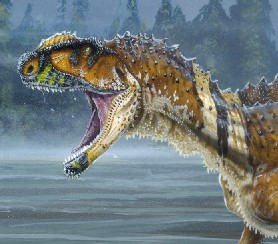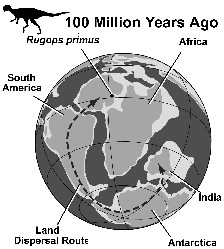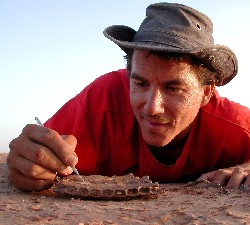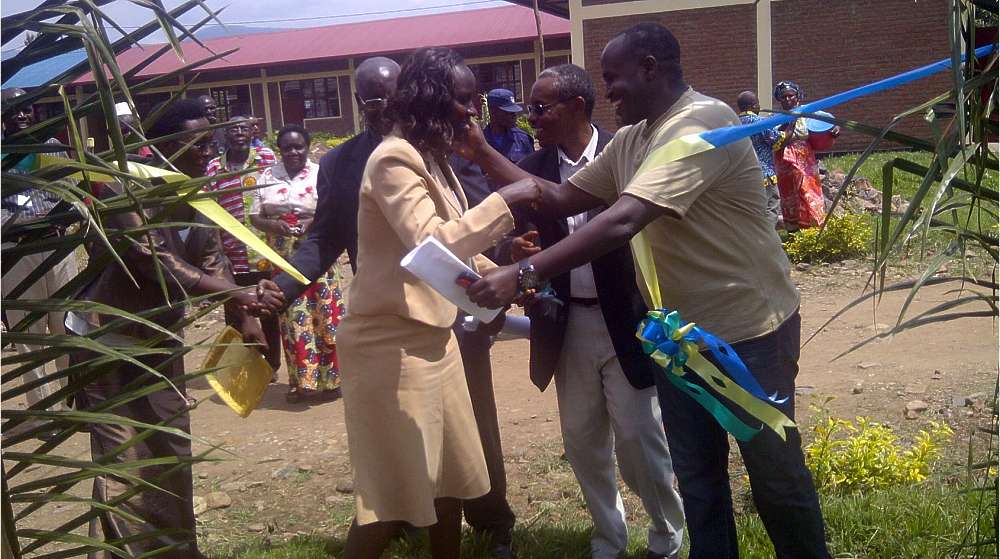|
Africa | Niger Science - Education | Environment - Nature Dinosaurs prove Africa is younger than assumed
The fossil skull of a wrinkle-faced, meat-eating dinosaur - whose cousins lived as far away as South America and India - has emerged from the African Sahara, discovered by a team led by University of Chicago palaeontologist Paul Sereno. The find provides fresh information about how and when the ancient southern continents of Africa, South America, Antarctica and India separated, the prominent researcher holds.
Mr Sereno adds he is puzzled by the presence of two neat rows of seven holes along the dinosaur's snout. He speculates that the holes anchored something ornamental, used by the animal for display. "This may have been a scavenger with head gear," he said. "It's really a beautiful intermediate species of the group that later evolved into the first horned predators." The authors of the scientific paper describing the two new dinosaur finds are Mr Sereno, Jeffrey Wilson of the University of Michigan and Jack Conrad of the University of Chicago. The second new dinosaur species, named Spinostropheus gautieri, was found in Niger in the same 135-million-year-old rocks where Mr Sereno's expeditions excavated the dinosaurs Jobaria and Afrovenator. The fossil is an articulated, or connected, spine of a dinosaur and represents an ancient relative of Rugops and other abelisaurids. These finds provide fresh evidence about when Africa, Madagascar, South America and India finally split from each other as a result of plate tectonics, or "continental drift". Before these discoveries, abelisaurids were virtually unknown on Africa, leading some to suggest that Africa had split off first from the southern landmass Gondwanaland, perhaps as early as 120 million years ago. The new fossils indicate that Africa and other southern continents that formed Gondwanaland s
Co-author and team member Jeffrey Wilson, assistant professor at the University of Michigan, said, "Until the continents fully separated, dinosaurs like Rugops and other animals used narrow land bridges to colonise adjacent continents and roam within a few degrees of the South Pole." The fossils were discovered on two separate expeditions that Mr Sereno led to Niger, one in 1997 and the other in 2000, which have brought to light many new dinosaurs and the 12-meter-long crocodilian Sarcosuchus. The US researcher recalls the day in 2000 when team member Hans Larsson, now an assistant professor at McGill University in Montreal, Canada, spotted a jawbone - and then, about half a meter away, the rest of the skull. "It was hard to see which end was the front, but we quickly realised we were looking at a brain case, and that it was probably an abelisaur - a huge find," Mr Sereno said. Both Rugops and Spinostropheus came from the Cretaceous Period, when this area of Africa featured broad rivers and lush plains. Today it is located in the southern Sahara Desert, part of Niger. Expeditions to the Sahara led by Mr Sereno in 1993, 1995, 1997 and 2000 unearthed a gallery of new dinosaurs, including the first from Africa's Cretaceous Period; they include Afrovenator, Jobaria, Deltadromeus, Carcharodontosaurus and Suchomimus. By staff writer © afrol News - Create an e-mail alert for Africa news - Create an e-mail alert for Niger news - Create an e-mail alert for Science - Education news - Create an e-mail alert for Environment - Nature news
On the Afrol News front page now
|
front page
| news
| countries
| archive
| currencies
| news alerts login
| about afrol News
| contact
| advertise
| español
©
afrol News.
Reproducing or buying afrol News' articles.
You can contact us at mail@afrol.com










